Bourbon barrels are made from fresh white oaks, but we’re running out of viable trees. Now, the very industry that contributed to the problem has the most invested in finding the solution.
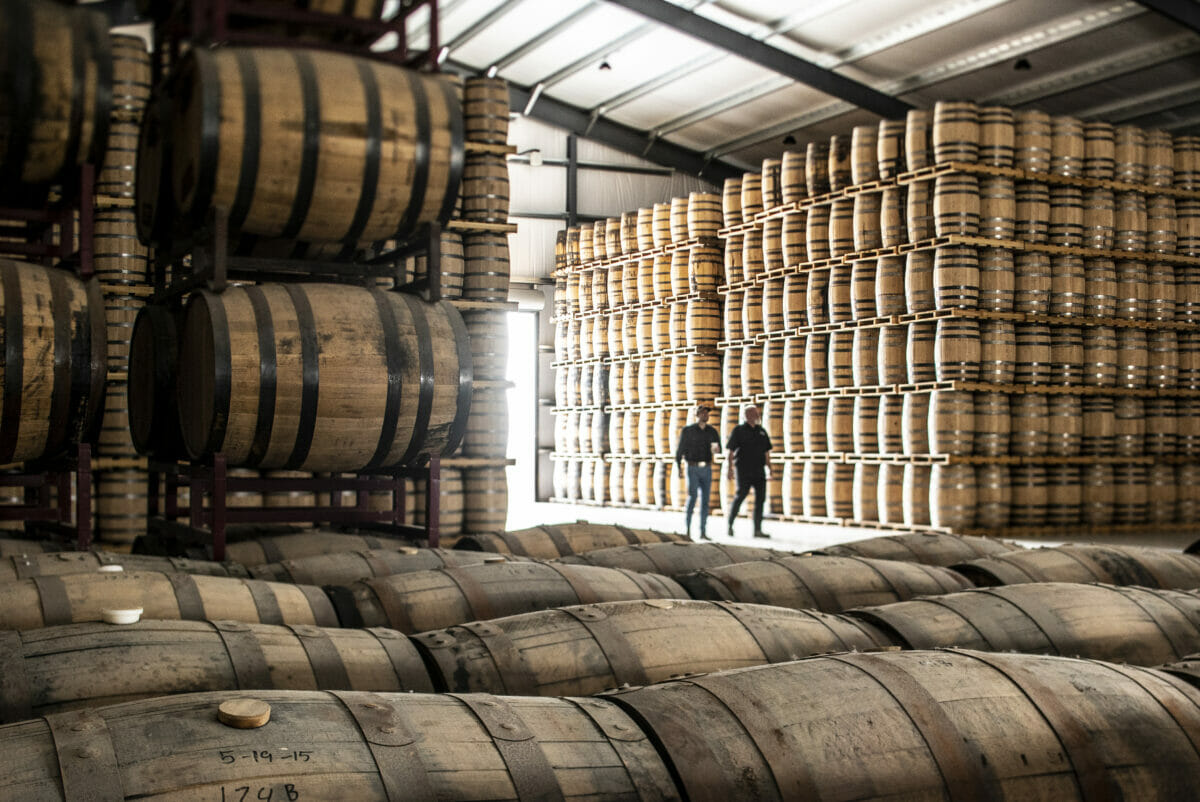
There are five key rules to follow when making bourbon whiskey. First, it must be distilled in the United States, and it must be a grain mixture with at least 51 percent corn mash. There can be no additives for color or flavor, and the alcohol content must be at least 80 proof at the time of bottling.
Most importantly, however, is that bourbon whiskey must be aged in a fresh, white oak barrel for a minimum of two years.
If you don’t follow those rules, you don’t have bourbon. But it’s that last policy that could be a problem in the coming decades. White oaks, or Quercus alba, are not thriving, and it’s not yet clear how bad the damage could be in the coming years. The White Oak Initiative, a group of researchers, government agencies and industry insiders dedicated to conservation, estimates that there are more than 100 million acres of white oak across the US, and roughly 75 percent of that is mature. That means that while the population of white oak is safe for the next decade or so, after that, it will be in rapid decline.
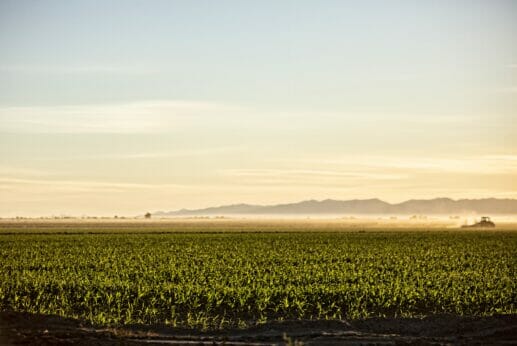
The corn field at Frey Ranch Distillery. Photography courtesy of Frey Ranch.
What happened to all the oaks?
Historically, white oak trees have flourished in North American forests, typically up and down the eastern half of the continent. Oaks are trees that benefit from disturbance in the forest; they’re fairly fire and drought tolerant, and they compete well when forests are grazed. But as logging ramped up and controlled burning fell, oaks began to suffer. Ironically, our relatively recent “hands off” approach to forestry is creating exactly the wrong kinds of conditions for oaks to thrive.
“We stopped burning our forests; there was extensive fire suppression, and there was a lot less subsistence agriculture and disturbance of the landscape,” says John Lhotka , an assistant professor of silviculture at the University of Kentucky, about the change in the 20th century. Because we stopped interfering with the forests, the areas became denser as more tree species crowded in the clearings. Oaks, as it turns out, do not have good “bolting,” meaning they don’t grow tall very quickly. When they’re in these new, denser forests, the oaks are now crowded out and can’t break through the tree canopy to receive enough sunlight, so they die. Then, more shade-tolerant trees such as maple and beech take over.
That’s left us with an age-gap problem. Oaks take a long time to mature—close to 90 years. Some oaks don’t even give off acorns until they’re 30 or 40 years old. Throughout the US, we now have an uneven age distribution of oaks, with a lot of oaks nearing maturity, but few very old or very young trees. It’s not clear exactly how many trees there are across the country, but forest inventories consistently show the same data: We have mature oak trees now. But in the next 10 years, 20 years or 30? It’s not looking good.
Oak trees are used in all sorts of industries: veneer, flooring, cabinetry and all manner of wooden construction. But oak barrels, the kind needed for bourbon distilling, are made from only the best trees. Each barrel is made from about 30 pieces of oak, also known as staves, tightly lashed together like puzzle pieces to ensure they are watertight. The vast majority—95 percent—of all bourbon is produced in Kentucky, and according to the Kentucky Distillers’ Association, the state’s bourbon producers filled 2.6 million barrels in 2021. Bourbon production overall in the state has increased 475 percent since 1999. That’s tens of millions of board-feet of lumber used every year.
While the distilling industry has not been the biggest contributor to the decline of oaks, it does seek out premium specimens, which are getting harder to find. That’s why distillers are now some of the biggest proponents of not just saving American white oaks but finding ways to speed up genetic research to produce higher-quality trees quicker. “They’re some of the most forward thinkers in the industry, because their business is long term,”says Lhotka. “When they put up barrels in warehouses, that’s thousands of [barrels] a year, so they have a much longer term viewpoint than the average landowner or sawmill owner.”
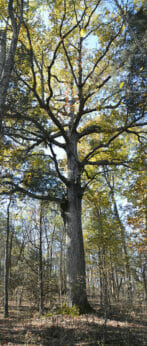
The ‘Mother Tree’ at Star Hill Farm. Photography courtesy of Maker’s Mark.
Mapping the mother tree
In 2021, the University of Kentucky announced its intentions to create the largest repository of American white oak. Its new partner? Maker’s Mark, the legendary bourbon distiller. The university began the project by collecting 300 distinct families of white oak from around the US and planting them at Star Hill Farm, the home of Maker’s Mark.
That first year, farm workers and researchers planted 1,700 individual trees. In 2022, another 2,200 trees went into the ground. This April, the group planted more than 5,000 trees. And the initial scope of the project has grown, too. “In the beginning, we thought there would be 300 representations of white oak, unique variations from around the US. But by the time we got into year two, it’s actually closer to 400,” says Brian Mattingly, director of Star Hill Farms. At this point, Mattingly is open to any new, interesting genetic representations of Quercus alba out there. Currently, he’s looking into a research forest in central Indiana with a crop of white oak. “We’re going to bring some of those in next spring…At that point, we’ll have every known, worthy specimen represented.”
The goal of the research repository is to grow all of these variations of white oak under the same conditions in Loretto, Kentucky (the home of bourbon), and see which ones thrive. Mattingly is testing for vigor, bolting, acorn production and elements important to a barrel manufacturer: tannins and taste. As bourbon ages in an oak barrel, the wood swells and shrinks with the weather, pushing the alcohol in and out of its pores. After several years, the bourbon takes on the taste of the tannins naturally present in the wood, so Mattingly wants to make sure those tannins are up to snuff.
Each tree in the repository is tagged with the exact state, county and GPS coordinates of its parent tree. That way, if certain trees start performing well, Mattingly and his team know exactly where to go to find more acorns. “Then we can begin grafting or cross breeding to create superior seedlings for that particular trait.”
Then, the next phase of the project can begin. Let’s say the team comes across a particularly superior seedling. These trees have good bolting, they’re strong and their seeds are excellent genetic material. Well, Mattingly has at his disposal thousands of oak trees, all at various ages and stages of growth. “We can go in and interplant this improved seedling, and those trees then will pollinate mature trees that are already making acorns. Now their acorns have improved genetics, and it’s spreading out.” As it takes 90 years for an oak to fully mature, anything to speed up the process is a help.
This tree bank is the second phase of a collaboration between Maker’s Mark and the University of Kentucky. The first is an effort to map the genome of the white oak, by studying the genetics of the “Mother tree.” The Mother tree, referred to in this mapping as “MM1” is one of the oldest white oaks in Kentucky, between 300 and 500 years old. It’s stood on the Star Hill Farms property for centuries and has been exposed to incredible changes in climate throughout its life. By mapping the genome of this tree, researchers hope to learn about its longevity and disease resistance, which could help them know what to look for as their new trees grow.
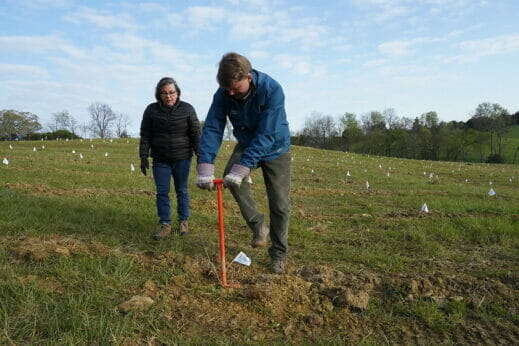
Planting trees at the Star Hill Farm white oak repository. Photography courtesy of Maker’s Mark.
‘You can’t take without giving back’
Kentucky is the old-school home of bourbon, but there are sustainability-minded distillers outside of the state that might be considered the new wave of whiskey. For some, such as Nevada’s Frey Ranch, the sustainability of the spirit is infused in every aspect of their business.
Founder Colby Frey likes to call himself a “whiskey farmer,” because all of the grain used in Frey’s bourbon is grown on-site at the ranch. Colby and his wife Ashley first got their distilling license in 2006, before craft distilleries were legal in Nevada. They experimented with making bourbon for years before they could actually sell it or distribute it. And in that time, they focused on what they say are the most important parts of their business: how to ensure their whiskey production, from the barrels to the bottles, is as sustainable as possible. “As fifth-generation stewards of the land, we aim to leave the land better than we found it,” says Frey.
The cooperages that make Frey’s barrels, including the Independent Stave Company and the West Virginia Great Barrel Company, use the wood chips and sawdust created in the building process to char the barrels’ insides, so they don’t bring gas or propane into the process. Frey calls it “common sense sustainability.” And while there are rules about how bourbon is made, the process is one that Frey thinks about a lot.
“One of the requirements for bourbon is that it has to be put in a new American oak barrel. You can’t reuse barrels. That’s kind of a limiting factor. If I could, maybe we’d put it in a used barrel and age it for eight or 10 years, instead of five or six, and maybe we could get the same flavors. I don’t know, because we really can’t do that with bourbon,” says Frey. However, many of Frey’s, Maker’s Mark and other bourbon barrels do see a second life—there’s a growing market for wine, beer, rum and other spirits aged in used bourbon barrels. Even finishing a spirit in a bourbon barrel (putting the spirit into a barrel for just a few months before it’s ready) can impart some of the classic bourbon flavors.
Even though Frey might not have access to acres and acres of white oaks (tree plantations are a bit sparse in Nevada), he supports the planting and research projects, and he talks about the issues with customers and other distillers. “Distillers today are just the stewards of their distillery, the forest, everything. If we don’t give back to the forest, then our kids and the next generation are going to pay for it.”
Other distillers are getting involved in conservation efforts as well. Both Sazerac and Brown-Forman, well-established spirit producers with brands such as Jack Daniels and Southern Comfort, are members of the White Oak Initiative. The Old Forester distillery team planted a five-acre tree nursery in support of Earth Day this past spring. Buffalo Trace has also partnered with the University of Kentucky on a separate research project, planting more than 1,000 trees at the distillery’s farm to look into how best to establish white oak seedlings.
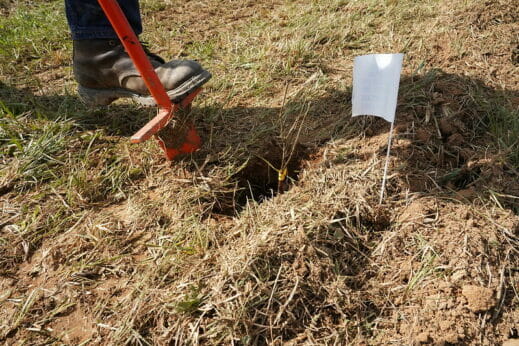
Planting trees at Star Hill Farm white oak repository. Photography courtesy of Maker’s Mark.
Warming oaks
After all of this, you might be wondering—what’s so special about oak? Could we age bourbon in barrels made of maple, beech or walnut trees?
Oak’s appeal lies in the combination of the sugars and tannins found in the tree, along with the hardness and porousness of the wood. Mattingly says there have been trials and studies using other trees, including species of oak found in France. “We know that if you use French oak, it changes the flavor immensely. And we also know that those barrels are insanely expensive and they don’t hold the liquid the way that white oak does, so they’re not financially feasible.”
So, distillers are invested in the future of white oak. It’s a money-maker for the forestry industry. But it’s also incredibly important ecologically. “The biodiversity that you see in an oak forest is much higher [than in a maple or beech forest],” says Mike Saunders, professor of silviculture at Purdue University. There are more insects, mammals and birds found in oak-dominant forests, because it doesn’t have much of a tree canopy, so it allows a lot of light to get to the ground. “There’s a higher diversity of [butterflies] that use oak for their larval stages. There’s a lot of caterpillars; that means there’s a lot of birds and bats that clean those caterpillars off of the oak foliage.”
As the climate warms, forests around the US are changing. But interestingly, white oaks might do well in warmer temperatures. Saunders says the compositions of forests could shift towards oaks, if you know where to source them from. “In Indiana here, I might want to collect seed from Tennessee or Kentucky, to look south and maybe slightly west, where it’s more drought tolerant.”
But in order to get that far, we’ll need the trees of today to make it to maturity.
Our White Oaks here in SW Illinois are suffocating from waves of 2,4-d and dicamba vapor drift floating miles from wherever it was applied. After 6 years of this our White Oaks have leaves the size of a cat’s ear and they are curled, cupped, very tough, and misshapen, but still green. Then the tree dies! Our area is in the midst of a huge Salvage Harvest of White Oak. The saplings are in the woods, but also show leaves that indicate herbicide damage. We find oak leaves 200 acres inside dense timber that test with up to 140 ppb… Read more »
There is no 2 year rule for bourbon. The TTB says it only needs to be in a new oak barrel, but they give no time limits for simple Bourbon.
A very informative article and well written.
They need to change the law so barrels can be reused. They make great whiskey in Scotland and Ireland and reuse the barrels all the time.
Wrong, wrong, wrong. You do NOT have to age the distillate for a minimum of two years for it to be legally classified as Bourbon.
I have a white oak in my front yard about 48-50 yrs old. It throws big acorns like crazy. Last year was a bumper crop.
Where did you get your information? White Oak was used for wine barrels way before Bourbon was a hot commodity. It’s the clear cutting that is messing things up not Bourbon.
“There are no regulations as to how long bourbon must age, but to be labeled straight bourbon it must age for at least two years in new charred oak.”
We toured the International Stave Company facility in Lebanon, KY. It was very interesting to see the barrels made. There is a lot of craftsmanship involved. The main thing I got from the tour was that each mature white oak tree (about 100 years old) makes only two barrels. They can only use the trunk of the tree, as it cannot contain any knots (which would leak) and the wood has to be very high quality, no insect holes, splits or rot. But the quality of our forests is in decline due to climate change, invasive insects etc. Also, Red… Read more »
Everything is give and take. In order to preserve our way of life we should be prepared to give back to nature along the way.